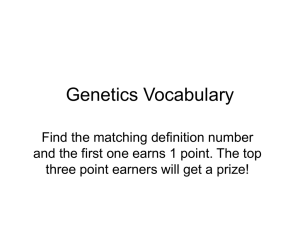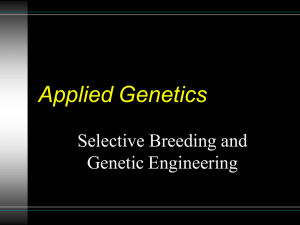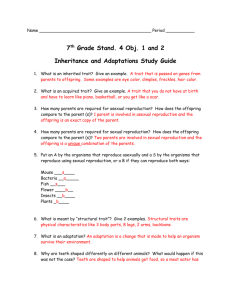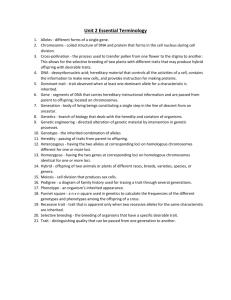How can you identify a sex-linked trait?
advertisement
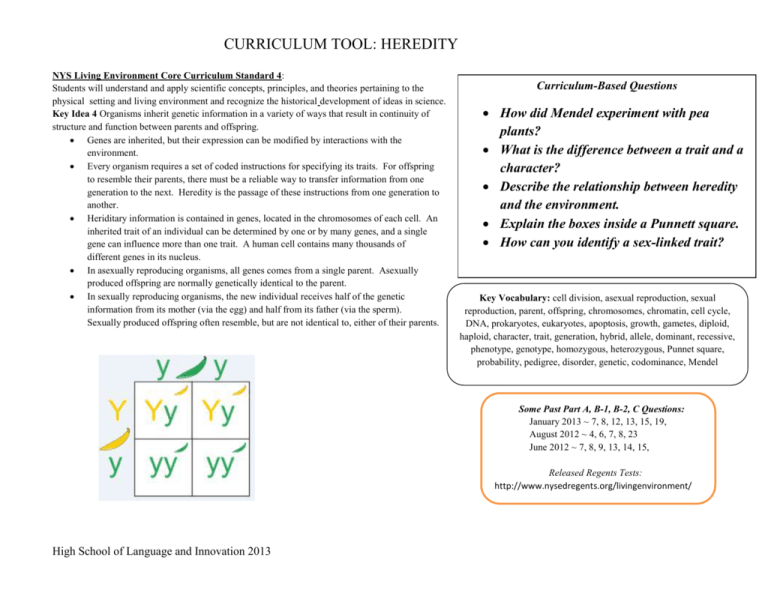
CURRICULUM TOOL: HEREDITY NYS Living Environment Core Curriculum Standard 4: Students will understand and apply scientific concepts, principles, and theories pertaining to the physical setting and living environment and recognize the historical development of ideas in science. Key Idea 4 Organisms inherit genetic information in a variety of ways that result in continuity of structure and function between parents and offspring. Genes are inherited, but their expression can be modified by interactions with the environment. Every organism requires a set of coded instructions for specifying its traits. For offspring to resemble their parents, there must be a reliable way to transfer information from one generation to the next. Heredity is the passage of these instructions from one generation to another. Heriditary information is contained in genes, located in the chromosomes of each cell. An inherited trait of an individual can be determined by one or by many genes, and a single gene can influence more than one trait. A human cell contains many thousands of different genes in its nucleus. In asexually reproducing organisms, all genes comes from a single parent. Asexually produced offspring are normally genetically identical to the parent. In sexually reproducing organisms, the new individual receives half of the genetic information from its mother (via the egg) and half from its father (via the sperm). Sexually produced offspring often resemble, but are not identical to, either of their parents. Curriculum-Based Questions How did Mendel experiment with pea plants? What is the difference between a trait and a character? Describe the relationship between heredity and the environment. Explain the boxes inside a Punnett square. How can you identify a sex-linked trait? Key Vocabulary: cell division, asexual reproduction, sexual reproduction, parent, offspring, chromosomes, chromatin, cell cycle, DNA, prokaryotes, eukaryotes, apoptosis, growth, gametes, diploid, haploid, character, trait, generation, hybrid, allele, dominant, recessive, phenotype, genotype, homozygous, heterozygous, Punnet square, probability, pedigree, disorder, genetic, codominance, Mendel Some Past Part A, B-1, B-2, C Questions: January 2013 ~ 7, 8, 12, 13, 15, 19, August 2012 ~ 4, 6, 7, 8, 23 June 2012 ~ 7, 8, 9, 13, 14, 15, Released Regents Tests: http://www.nysedregents.org/livingenvironment/ High School of Language and Innovation 2013 CURRICULUM TOOL: HEREDITY 1. An organism that reproduces asexually will have offspring that have (1) the same genetic information as both of its parents (2) different genetic information from either of its parents (3) the same genes as its parent (4) different genes from its parent 3. Two methods of reproduction are represented in the diagram below. 2. The process of inserting this gene into the DNA of a tomato plant is known as (1) selective breeding (2) genetic engineering (3) cloning (4) replication How does the DNA in the offspring produced by these methods compare to the DNA in the original organism? (1) The offspring contain half the original number of chromosomes in each method. (2) The offspring DNA is genetically identical to the original organism in both methods. (3) The offspring produced by method A contain twice the original number of genes, while those produced by method B contain half the original number of genes. (4) The number of DNA bases is less than that of the original organism in method A, but more than the original organism in method B. Readings Prentice Hall Biology p. 341-365 Holt Living Environment p. 264-289 Holt Living Environment Spanish p. 264-289 Miller & Levine Biology p. 307-343 Websites http://www.brainpop.com/science/cellularlifeandgenetics/genetics/ http://www.untamedscience.com/biology/genetics https://www.khanacademy.org/science/biology/heredity-and-genetics http://highered.mcgraw-hill.com/sites/0072835125/student_view0/animations.html http://regentsprep.org/regents/biology/units/heredity/index.cfm THE FOLLOWING IS REQUIRED INDEPENDENT WORK http://www.brainpop.com/cellularlifeandgenetics/genetics/quiz/ graded quiz EMAIL TO: christinehunkele@yahoo.com or mcneilnakita@yahoo.com Holt McDougal Biology p. 155-177 High School of Language and Innovation 2013 Videos In-Class Activities In the womb Curriculum Tool Guide In the womb with multiples Worksheet station Activity stations In the womb with animals HIV/AIDS Discovery Human Body Common Core Writing Prompt CURRICULUM TOOL: HEREDITY Curriculum Tool Guide 1. How did Mendel experiment with pea plants? a. Define "cross" in terms of his experiment. b. Describe Mendel's experiment (colors of the plants, what he did, what the results were - Mendel's theory) c. What is the "blending" hypothesis? 2. What is the difference between a trait and a character? a. Define trait. b. Define character. c. Explain "hybrids". d. Define dominant and recessive. 3. Describe the relationship between heredity and the environment. a. Define heredity. b. Define genotype and phenotype c. How do heredity and the environment differ, and how are they the same? 4. Explain the boxes inside a Punnett square. a. What is a Punnett square. b. Define heterozygous and homozygous. c. What is the probability that a heterozygous cross will produce a homozygous recessive offspring? 5. How can you identify a sex-linked trait? a. Define sex linked trait. b. How can you know if a trait is sex-linked? c. Give an example of a sex-linked trait. High School of Language and Innovation 2013
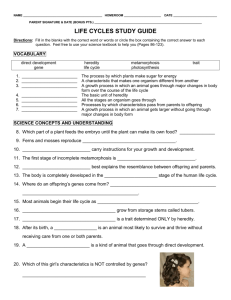


![Biology Chapter 3 Study Guide Heredity [12/10/2015]](http://s3.studylib.net/store/data/006638861_1-0d9e410b8030ad1b7ef4ddd4e479e8f1-300x300.png)

